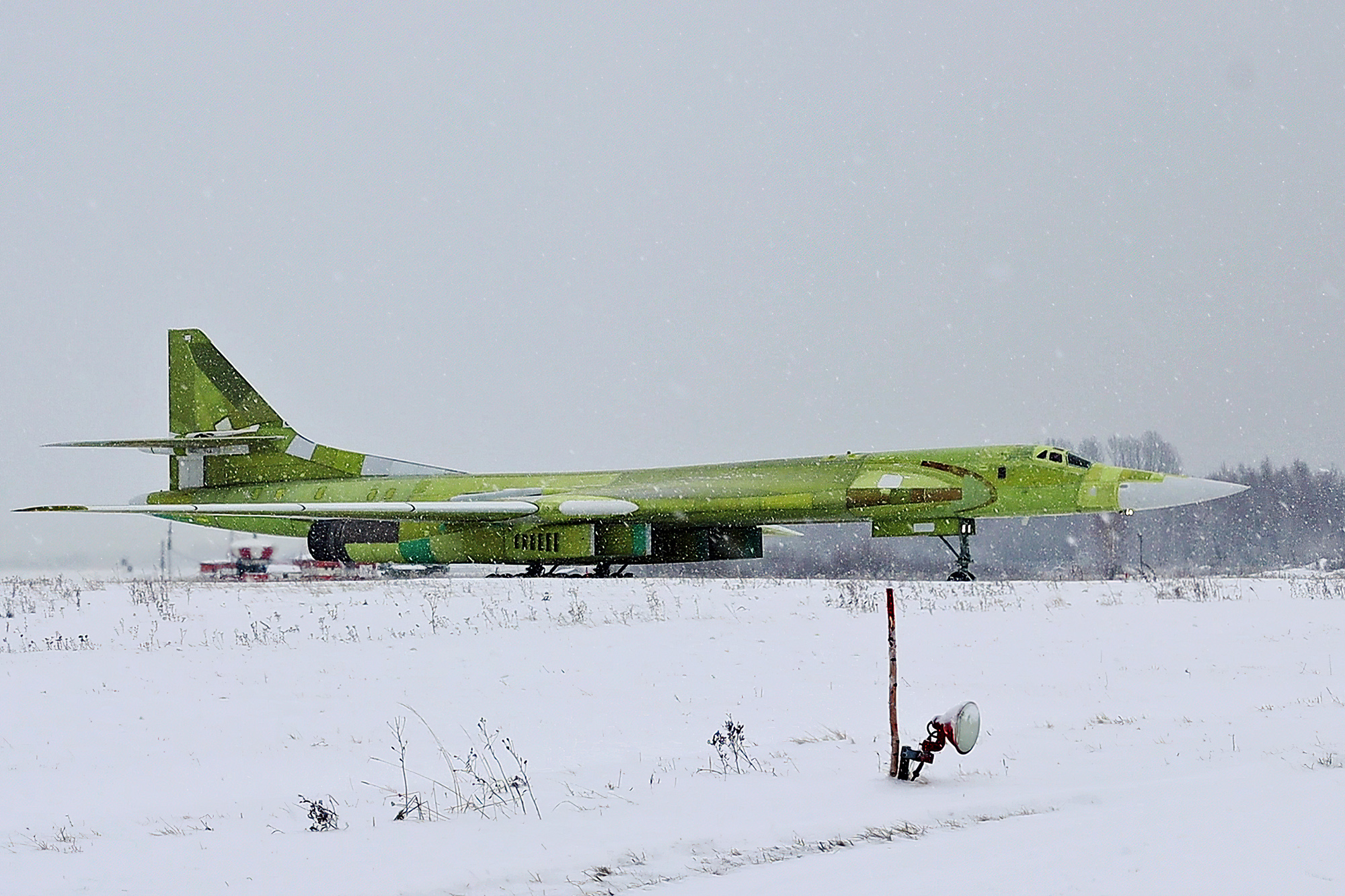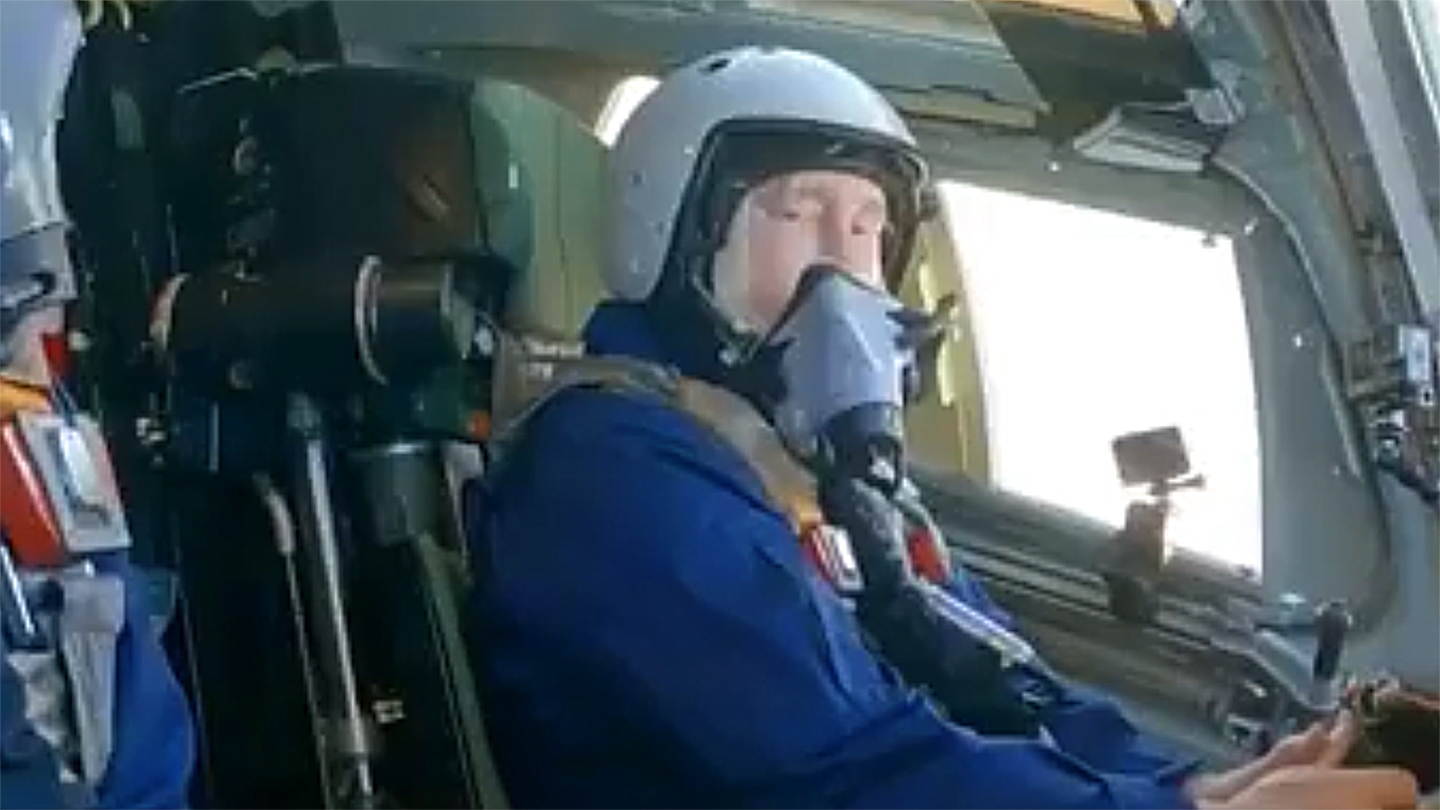The 71-year-old Russian President Vladimir Putin took to the air today aboard a modernized Tu-160M Blackjack strategic bomber, in a calculated move to send a signal of strength ahead of elections and as the second anniversary of Moscow’s full-scale invasion of Ukraine approaches. Putin’s flight also provides something of a shot in the arm for Russia’s military aerospace industry, which is currently in the doldrums. Sanctions, coupled with its pariah status, have caused significant export orders to have almost dried up entirely.
Russian state TV showed the Tu-160M with Putin aboard taking off from a runway at the bomber’s production facility, the Kazan Aviation Plant, western Russia, which is owned by Tupolev. In a highly energetic sequence, correspondent Pavel Zarubin breathlessly described it as “a unique event.”
That statement is not exactly true, of course, with Putin having previously flown in a (non-modernized) Tu-160 during a training exercise in 2005.

Interestingly, Putin arrived at the Tu-160 in one of his Aurus limousines, which took him right up to the flight line, where he then embarked with the rest of the crew.
According to Kremlin spokesperson Dmitry Peskov, the flight plan for the Tu-160M was a military secret, but the flight would last up to 40 minutes, TASS state news agency reported.

The Blackjack that Putin flew on today — named Ilya Muromets, after a character from Russian folklore — is a modernized aircraft, from previous production. Notably, it’s not one of the newly manufactured examples under contract for the Russian Aerospace Forces (VKS).

While the Blackjack is the most advanced strategic bomber available to Russia, its overall importance has always been limited, to some extent, by the relatively small numbers available. From the original production run, around 17 examples are now in service. This total was only achieved by Russia buying examples back from Ukraine, which inherited the bulk of the Tu-160 fleet after the demise of the Soviet Union.

As we have described in the past, the full-scale manufacture of the Tu-160 came to an end around 1995. After that, a handful more were completed using existing components. Finally, in 2015, Russia decided to relaunch production in the upgraded Tu-160M form, primarily as an interim measure due to delays in the PAK DA new-generation bomber program.
In January 2018, an order was placed for 10 new-build Tu-160Ms, each of which was expected to cost around $270 million, with the first example planned to be ready in 2021. While the Russian Ministry of Defense has said it wants to receive at least 50 new-build Tu-160M aircraft, no further orders have been placed since then.
In January 2022, the first new-build Tu-160M took to the air, as you can read about here.

Getting the Blackjack back into production has been far from easy. Even before the full-scale invasion of Ukraine, there was the problem of reinstating production jigs and tooling, much of which likely no longer existed.
Once the invasion began, these difficulties would only have increased. As well as the simple problem of resources — including finances — being redirected toward the war effort, there are well-publicized issues in obtaining high-technology components from foreign producers. The Tu-160M2 will likely not have been immune from this.
According to Piotr Butowski, an expert on Russian aircraft and a contributor to The War Zone, probably only three new-build Tu-160Ms have been completed so far. The first is undergoing tests with the Ministry of Defense, while the next two are supposed to be “close to delivery,” according to Russian accounts. None are so far assigned to the operational unit, which is meanwhile making heavy use of the original Blackjack fleet to launch cruise missiles against targets in Ukraine.

Ahead of his flight today, Putin was shown looking around a large hangar at the Kazan Aviation Plant which contained four Blackjacks (three of them are seen in the photo above). Of these aircraft, Butowski contends, two were new-build Tu-160Ms, while the other two were earlier aircraft that have been modernized.
Confusingly, the upgraded aircraft are also known as Tu-160Ms.
At one point, the new-build aircraft were to be designated Tu-160M2, while modernized aircraft would be known as Tu-160M. The supposed commonality between the older, upgraded jets and the new series means they both now share a designation. The first upgraded (as opposed to new-build) Tu-160M took to the air in February 2020.

As we have discussed in the past, the Tu-160M is based around an entirely new mission system and avionics. This includes a new radar, digital cockpit displays, flight control system, navigation equipment, and communication suite. A new self-protection suite is also installed.
Among the most difficult aspects of getting the Blackjack back into production was the requirement for new engines, with the original Kuznetsov NK-32 turbofan, the most powerful combat aircraft engine on Earth, long being out of production. The modernized and supposedly more efficient NK-32-02 was developed for the Tu-160M and began flight testing in November 2020.
Most critically, perhaps, the Tu-160M is also intended to receive a range of new weapons, although the exact status of the relevant programs is shrouded in secrecy.
Among the weapons intended for the Tu-160M’s future arsenal is the Kh-SD, understood to be a subsonic missile with the same guidance system as the Kh-101 cruise missile now in service, but with a smaller airframe and improved low-observable features.

Meanwhile, the Kh-BD is intended as Russia’s next-generation long-range air-launched cruise missile and is likely to be a further development of the existing Kh-101 and Kh-102, albeit with a significantly greater range, in the region of 3,700 miles. Last September, Russia claimed to have introduced this missile, but no confirmed imagery has ever been released. You can read all about this intriguing program here.
The most ambitious of these missiles is the Kh-MTs, which is being developed under the GZUR hypersonic weapons program. This is reportedly a ramjet-powered missile with a speed of Mach 6 and a range of over 900 miles when flying in a high-altitude profile.
Once again, the difficulties in securing funding as well as the requisite high-technology components, especially semiconductors, have likely had an adverse effect on one or more of these programs. At the same time, the much heavier than anticipated use of cruise missiles in the Ukraine war has apparently rapidly burnt through stocks of existing air-launched cruise missiles.

The requirement to replenish stocks of existing missiles will presumably take precedence over the development of new and unproven ones, at least for the time being.
At the same time, as well as needing new missiles, the VKS is very likely looking forward to the receipt of new-build Tu-160Ms, whenever that might be. While launching cruise missiles against Ukraine doesn’t require much more than a short hop from their base, the fleet is still in demand for other missions, too, including the long-range ‘patrol’ flights around NATO adversaries and deployments to new and renovated airbases in the Arctic. After all, the Tu-160 (together with the Tu-95MS and Tu-22M3) constitutes one arm of the Russian strategic nuclear triad.

Moreover, the VKS has not received a genuine new-build bomber of any kind since the mid-1990s.
While the picture as regards new-build bombers is hardly inspiring, despite Putin’s high-profile flight today, more concerning for Moscow is surely the country’s dwindling export success in the military aerospace sector overall.
Official Russian Ministry of Defense video of a Tu-160 flight over the waters of the Barents, Norwegian and North Seas, in 2019:

With the Singapore Airshow taking place this week, Russia’s absence from this major trade event — as well as its changing fortunes in the Indo-Pacific region more generally — has been noted.
“In this region, you have seen a shift away from Russian equipment already,” Robert Hewson, a spokesperson for Sweden’s Saab, told Reuters.
As well as sanctions prohibiting international arms sales directly from Russia, there is the overarching reality that, when it comes to buying military aircraft, most of the world would currently rather not do business with Russia.
Previous customers are actively stepping away from buying more Russian military aircraft. An example is Malaysia, which acquired 18 Su-30MKM Flanker multirole fighters from Russia in 2003. Russia has not traditionally had a good reputation for in-service support and parts for the Malaysian Su-30s are running low.
One Malaysian Su-30 pilot says that there soon “may be next to none at all left flying,” according to a report from Defense News.

This has become a common situation for Russian aircraft of all types since the all-out invasion of Ukraine began, leading to a rush to Western aircraft types by foreign users that have long stuck with Russian equipment.
Regardless, Malaysia is now looking elsewhere for its military aircraft needs, including a deal last year for 18 South Korean FA-50 light combat aircraft worth more than $1 billion.
Indeed, since the full-scale invasion of Ukraine, the only prospect of a major sale of Russian fighters has been a mooted transfer of Su-35 Flankers to Iran. These aircraft were originally built for Egypt, before that deal was shelved, and, should they be supplied to Iran, it will likely be as some kind of exchange for Tehran’s support in Russia’s war, which has chiefly come in the form of one-way attack drones and, more recently, ballistic missiles.

The only other deal of note since February 2022 also involved Flankers that were built for another country being sold on. Ethiopia recently took delivery of a pair of Su-30K Flankers, originally built as interim equipment for India before being put into storage in Belarus. After overhaul, the two fighters were delivered to Ethiopia in a deal that’s understood to have been orchestrated by Russia.
There are deeper problems affecting Russian aerospace industries, too, with reports of looming shortages in skilled labor, compounded by an aging population. According to the former deputy prime minister and head of Roscosmos, Yuri Borisov, there will be a lack of 400,000 workers across the Russian defense industry in the near future.
All in all, the picture is a depressing one, from a Russian perspective, especially in contrast to the period between 2000 and 2010, when lucrative export orders, especially from China and India, essentially propped up Moscow’s military aerospace industry, providing much-needed funds for development of new projects that in turn benefited the Russian Armed Forces. India, in particular, is increasingly looking to Western arms suppliers as it seeks to move away from its reliance on Russia, while China is able to meet almost all of its military aircraft requirements itself.

With few prospects of this situation changing any time soon, Putin’s visit to the Kazan Aviation Plant serves little more than boosting his own reputation ahead of elections next month. At the same time, there’s little sign that the Tu-160M2 program is bringing any benefits to the Russian military just yet.
As it is, the opportunity for the Russian leader to make a highly symbolic flight aboard a nuclear-capable bomber, as relations with the West hit a new low in the wake of the death of Alexei Navalny and the upcoming second anniversary of the full-scale invasion of Ukraine, seems to have been too good to miss.
Contact the author: thomas@thewarzone.com
